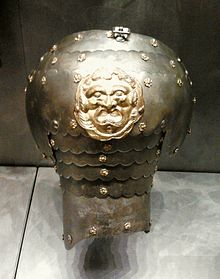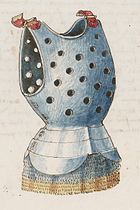Jousting
The pauldron of a knight was also important in jousts. While most points in a jousting competition were scored by unhorsing the opponent or striking the lance, points could also be scored if a lance was to hit the enemy pauldron, albeit for lesser points than a true strike. [3] Many pauldron styles used a lance rest to assist in the joust, allowing the knight an area to ready the lance for stronger blows. The pauldron would typically be cut shorter to allow this rest without restricting arm mobility or the rider's protection. Typically, only the right pauldron would support this cut-away, as this was the lance arm of the knights contending in a joust.
Typical tournament armor for jousting would be padded with cloth to minimize injury from an opponent's lance and prevent the metal of the pauldron from scraping against the breastplate. This protective cloth padding would extend about half an inch from the rolled edge of the armor, and it was secured in place with rivets along the entire edge. This cloth protection could not be too thick in battle, or the knight would have no arm mobility. However, in a safer tournament setting, mobility was less important compared to safety, thus leading to heavier padding. In fact, knights in this era could be padded to the point where they look "more wide than tall" compared to contemporary depictions of jousting armor. [4]
This page is based on this
Wikipedia article Text is available under the
CC BY-SA 4.0 license; additional terms may apply.
Images, videos and audio are available under their respective licenses.


